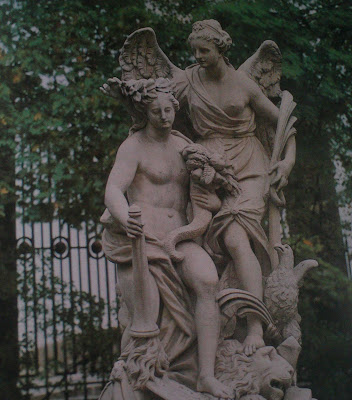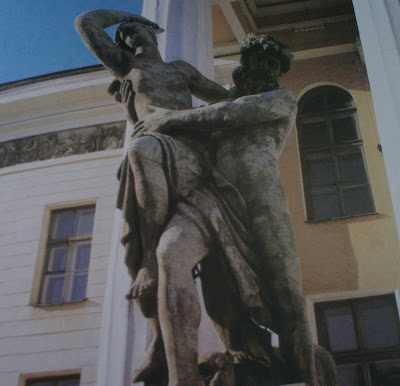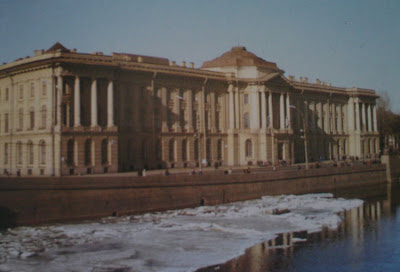The Summer Garden
 The Summer Garden and the Summer Palace of Peter the Great are magnificent examples of early 18th century Russian architecture and landscape gardening.
The Summer Garden and the Summer Palace of Peter the Great are magnificent examples of early 18th century Russian architecture and landscape gardening.The gardens were laid out in 1704 in the formal style by the architects Matveyev,Zemtsov, the gardeners Jan Roosen, Surmin, Lukyanov and others. Many of the elements that go to make a formal garden have not come down to our day, but the geometric lay-out of the garden's avenues and walks and its unique collection of marble statuary by early 18th century Italian masters have been preserved intact.
From the Neva side the Summer Garden are bordered by railings of magnificent ironwork, designed by Yury Valten. The strict forms of the railings and their clear-cut composition put them on a par with the finest works of Russian Classicism.
 The pavilions, arbours, fountains and other ornamental structures of the Summer Garden were destroyed by flood in 1777 and were never rebuilt. The existing Coffe- and Tea-houses were constructed by Louis Charlemagne and Carlo Rossi only in the 19th century.
The pavilions, arbours, fountains and other ornamental structures of the Summer Garden were destroyed by flood in 1777 and were never rebuilt. The existing Coffe- and Tea-houses were constructed by Louis Charlemagne and Carlo Rossi only in the 19th century.Installed here in 1855 was a monument by Piotr Klodt to Krylov, the eminent Russian fabulist.
The Summer Garden rank among the most popular pleasure grounds of Saint Petersburg.
Peter the Great’s Summer Palace was the monarch’s state residence in St. Petersburg. It was built between 1710 and 1712 to the design of Domenico Trezzini. The two-storey structure with a hipped roof is adorned with a frieze and low-relief compositions glorifying in allegorical form Russia’s victories in the Great Northern War.
Some of the rooms retain elements of their original decoration – tiled walls, carved panels and stucco mouldings. Of particular interest are Peter’s study, the Green Room, the Presence Room and some others. The Summer Palace was transformed into a museum in 1934. On display in its halls are works of fine and applied art, furniture and utility items characteristic of palace interiors in the first quarter of the 18th century.
Labels
The Summer Garden
The Mining Institute

 The building of the Mining Institute, a remarkable example of the classical style, was erected between 1806 and 1811 by Andrei Voronikhin to house the first technical school in Russia, later renamed the Mining Institute whose premises it has remained for over a century and a half.
The building of the Mining Institute, a remarkable example of the classical style, was erected between 1806 and 1811 by Andrei Voronikhin to house the first technical school in Russia, later renamed the Mining Institute whose premises it has remained for over a century and a half.The main façade is decorated with an imposing portico. The broad stairway is flanked by two sculptured groups: Heracles and Anteus by Stepan Pimenov and Pluto Carrying off Proserpina by Vasily Demuth-Malinovsky. On the frieze of the building, on either side of the portico, are two low-reliefs by Demuth-Malinovsky: Venus comes to Vulcan For Mars’s armour and Apollo comes for the chariot made for him by Vulcan.
The only surviving elements of Voronikhin’s original design are the Grand Staircase and the Hall of Columns whose ceiling was painted by Giovanni Battista Scotti.
Labels
The Mining Institute
Travel to Saint Petersburg
 Saint Petersburg travel is so exciting adventure that once visited Saint Petersburg you'll never forget it.
Saint Petersburg travel is so exciting adventure that once visited Saint Petersburg you'll never forget it.Saint Petersburg was founded on May, 16 1703 by Peter the Great. It has long been known as Russia's " Window to the West".
The main reason for Saint Petersburg travel is that Saint Petersburg has it’s own unique, unforgettable character. Compared to other large cities, Saint Petersburg is a mere youngster, only ninety years older than Washington. Ten years after it's foundation Saint Petersburg looked just about as Paris must have looked in the first few centuries A.D., consisting only of an island fortress and a handful of buildings stretched out along the banks of the river.
Youthful cities such as Saint Petersburg seldom acquire "character". This usually takes hundreds, even thousands of years. The same is also true of statues and buildings: Venus of Milo and the Acropolis would not be quite so interesting if they did not bear the marks of long, long life. Most cities, too, need time before countless generations can mould their character. The most marvelous thing about Saint Petersburg is that the rule does not hold true. The city was founded fairly recently, and, it may have seemed, in defiance of all reason: that is, on the swampy banks of a wild river, amidst dense forests, and between an ocean gulf and an enormous lake, both of which are ice-bounded almost half the year. But Saint Petersburg vital force could not be held in check. Saint Petersburg travel lets you feel all it’s force and power.
The Academy of Arts


The building of the Academy of Arts, one of the first examples of Russian Classicism, was put up between 1764 and 1788 by Alexander Kokorinov and Jean-Baptiste Vallin de la Mothe. The raised ground floor is decorated with rustication to look like a socle and is interspaced with arched windows; the first and second stories are unified by pilasters. The façade overlooking the Neva is articulated by main and side jutties decorated with Doric columns. The conference hall with two tiers of windows is crowned by a dome that lends an air of solemnity to the main façade. The suite of rooms on the first floor is the most imposing feature of the interior.
Several generations of painters, sculptors and architects studied and taught at the academy: Kramskoi, Kuinji, Repin, kozlovsky, Bazhenov, Starov anf many others.
The Museum of Art History, organized almost concurrently with the Academy of Art , has large collection of works of arts which reflects different styles of Russian academic and Soviet Art Schools.
The landing-stage in front of the Academy is adorned with two sphinxes carved in Egypt in the 13th century B.C. and brought to Russia in 1832. The sphinxes rest on granite monoliths flanking the steps leading down to the Neva.
Labels
The Academy of Arts
Subscribe to:
Posts (Atom)

